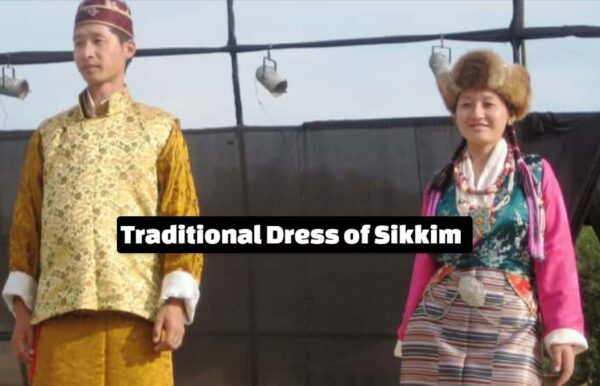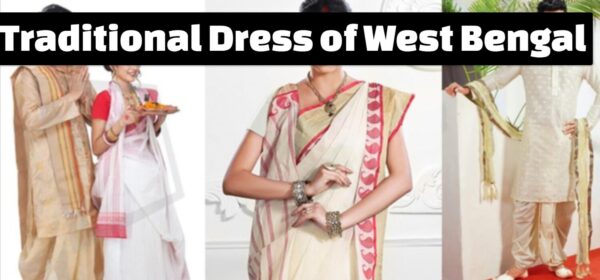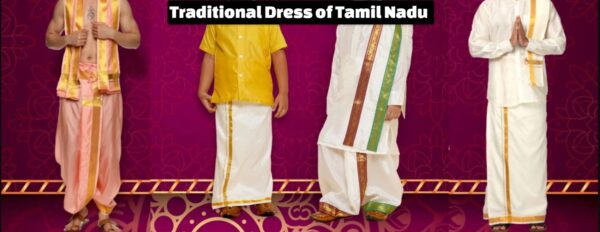Sikkim state’s specialties are serene rivers, breathtaking scenery, heartwarming dance forms, and lip-smacking savories. On top lies the traditional dress of Sikkim, which captivates the heart with its diversity and cultural importance. Let’s dive into this article, where you will learn about the Traditional Dress of Men and Women wear in Sikkim.
Also Read: Top 5 hardest Languages In India
In Sikkim, the dresses are classified according to the tribe’s status. Some of them are as follows:
1. Bhutia Tribal Dress
Bakhu is a tribal dress worn by both men and women. It is similar to a Tibetan chuba. Bakhu is a loose cloth tied around the neck and waist by a silk or cotton belt. The women wear it with Honju, a fully-sleeved silk blouse. A jacket called Kushen is also worn on it. Recently, there have been many variations, like the women pairing it with jeans.
2. Lepcha Tribal Dress
Lepcha men wear striped waistcoats, Dumpraa, with various colors. This waistcoat is pinned on the shoulder. A waistband is also used to hold the waistcoat, and it is called Gyatomu. Dumpraas are paired with ankle-length trousers and white-colored shirts. A traditional cap, Sumok Thyaktuk, enhances the overall look. The women wear ankle-length dresses, Dumden. It is paired with a loose-fitted blouse tago. Meanwhile, Naamrek is a kind of waistband that keeps the blouse tight. Gorey, a traditional cap, adds a tint of beauty to this mind-blowing dress.
3. Nepalese Tribal Dress
Almost 80% of Sikkim people are Nepalese. Nepalese men wear Daura, a broad knee-length coat paired with Suruwal, which is a loose trouser. A waistcoat known as Askot, cap Dhaki topi, and belt patauki gives a royal look to the attire. Women wear a Pharia that resembles a saree. The colors are primarily vibrant yellow or red. Pharia is paired with a chaubandi cholo, a loosely fitted long sleeves top. Alternatively, they wear a colossal cloth covering from head to toe with beautiful floral prints called Hembari. Majetro, an elegant shawl, and Pacheuri headgear complete the look. They also carry a sharp weapon known as Khukri in a leather case called Daab.
4. Thokro-Dum
Another main outfit of the Lepcha community is the Thokro-Dum. It is a long white pyjama up to the claves, like the attire of karate players. It is paired with a Lepa shirt, Yenthatse and Shambo, and an embroidered cap. The short length of the pajamas indicates that the men came from the marshy land of Sikkim. The rugged and durable material enables them to work in their fields quickly.
Traditional wedding attire of Sikkim
Sikkim’s traditional wedding outfits are filled with royalty and elegance. The beautiful bride and groom wear a conventional wedding Bakhu of the finest quality silk. The only additions to male attire are loose trousers, classy leather shoes, and a silky turban called a Topi.
In contrast, the females wear an exclusive colorful ‘Kho’ made of fine silk and brocade. This gorgeous full-length sleeve has alluring designs and intricate patterns. Kho is paired with a charming ‘Pangden’ apron. ‘Pangkham’ is a headgear that covers the head of the Sikkimese bride. These are larger, intrinsic multicolored scarfs.
Traditional Jewellery worn by Sikkimese Women
- Bhutias Jewellery—Bhutias women wear Joko (ring), Phiru (pearl jewelry), Yencho (earring), Diu (gold bangles), Khalli (anklet), and Khao( thick anklets). They have a massive liking for pure gold jewelry.
- Nepalese Jewelry—The main elements of Nepalese jewelry are Sir-Bandi (a bejeweled tiara), Kantha (necklace), Naugeri (pearl necklace), and Charanihari (necklace). These pieces look stunning when paired with traditional Nepalese tribal dress.
- Lepchas Jewellery- Lepchas wear Lyak (necklace), Namchok (earring), and Gyar (necklace) as their chief ornaments. Adding to this, they also wear tiny bracelets on their wrist. Gold and silver are the primary metals used in these ornaments.
Conclusion
Sikkimese’s outfits and jewelry combine comfort, diversity, and beauty. Each tribe of Sikhim has unique costumes that show their identity and heritage. From majestic Bakhu to colorful Pharia, every piece holds significance and cultural importance. The traditional wedding dresses are particularly exquisite, adorned with intricate designs and precious metals. Sikkim’s traditional dress is more than just clothing; it’s a window into the soul of its people and their enduring traditions.




